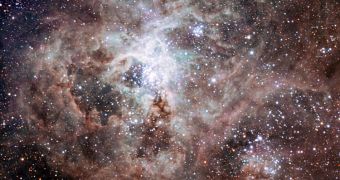Officials at the European Southern Observatory (ESO) announce that a new robotic telescope has just seen its “first light” at the La Silla Observatory complex, in Chile. The TRAnsiting Planets and PlanetesImals Small Telescope (TRAPPIST) is especially designed to study exoplanetary systems, as in stars and their respective planets and moons that lie outside of our solar system. There are some chances that some of these worlds may have the necessary conditions for supporting some forms of life, and researchers are hopeful that investigating them may help advance the field of astrobiology.
The new instrument will employ two main methods of investigation, each aimed at particular sets of targets. In the first one, it will attempt to detect exoplanets, and then provide astronomers with as much information about their orbits, shapes, sizes, atmospheres and surfaces as possible. Comets will represent the second set of targets, and the ones that orbit the Sun will represent the main objective of this second approach. Operational control of TRAPPIST will be ensured by a control room located no less than 12,000 kilometers away from La Silla, in Liege, Belgium.
“The two themes of the TRAPPIST project are important parts of an emerging interdisciplinary field of research – astrobiology – that aims at studying the origin and distribution of life in the Universe,” says the leader of the telescope's exoplanetary studies, Michael Gillon. “Terrestrial planets similar to our Earth are obvious targets for the search for life outside the Solar System, while comets are suspected to have played an important role in the appearance and development of life on our planet,” argues Emmanuel Jehin, who is in charge of the future cometary studies that will be performed with the new telescope.
“ESO’s La Silla Observatory on the outskirts of the Atacama Desert is certainly one of the best astronomical sites in the world. And because it is already home to two superb exoplanet hunters, we couldn’t have found a better place to install our robotic telescope,” Gillon adds. He is referring to the fact that the new observatory will join two additional instruments already at the facility. One is the HARPS, on the 3.6-meter telescope, and the other is CORALIE, a device attached to the Swiss 1.2-meter Leonhard Euler Telescope.
TRAPPIST is fully automated and capable of moving at very high-speed with incredible precision. This means that astronomers can program it to track a certain target, and then leave it unattended for hours on end. The 0.6-meter telescope will remain focused at all times, moving seamlessly to capture the motion of the objects it is imaging. The dome covering the machine is controlled by an automated weather station, which is in charge of deciding when to cover the observatory, and when to retract the roof.

 14 DAY TRIAL //
14 DAY TRIAL //